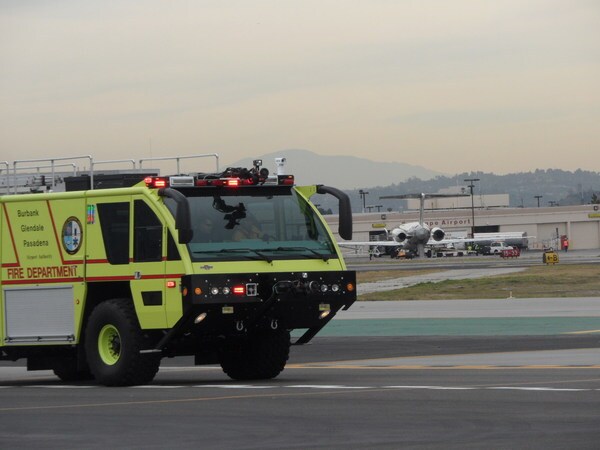Bob Hope Airport Introduces New Aircraft Rescue and Firefighting Vehicle

Bob Hope Airport is slowly rolling out new aircraft rescue and firefighting trucks, starting with the first US Class 4 Aircraft Rescue and Firefighting vehicle (ARFF) in the country. Rosenbauer America, the same company whose Panther 6x6 Aircraft Rescue Fire Fighting vehicle was featured as the character Sentinel Prime in "Transformers 3," designed the new truck.
The vehicle is superior to previous models - using a careful mixture of compressed air, foam solution and water to generate a firefighting agent that uses less water.
"At an airport we don't have a lot of above ground water supplies because we have restrictions on side hydrants," said fire Capt. Marcus Domingo. "We need to be able to conserve as much firefighting agent as we can."
The truck carries 1500 gallons of water, 200 gallons of foam, and 500 pounds of halotron, a clean firefighting agent that doesn't leave a residue or pollute the environment. The truck can also travel 75 mph and reach 50 mph in 35 seconds, allowing it to respond to the furthest portion of the airfield from the airport fire department for an emergency landing in less than three minutes.

"When we have a fire outside of the aircraft we have less than two minutes before fire will burn through the aircraft," said Domingo.
Aircraft accidents, especially those involving commercial airliners, are rare. The last major incident at Bob Hope Airport was on March 5, 2000 when a Southwest flight went through a fence during a landing and stopped on a street across from a gas station. A result of the incident, the airport installed an Engineered Materials Arrestor System (EMAS) on the runway to slow down a plane that is landing too fast.
"It's an engineering material where it allows the aircraft to crash gracefully, if you will, and its designed to slow it down," said Domingo.
Also as a result of that incident the gas station across the street from where the Southwest flight landed was demolished due to safety concerns. It is now a green space.
These preventative and precautionary measures, Domingo explained, have made the airport even safer. "The airport is very good about protecting its passengers," he said. "We were fortunate enough that when we bought the ARFF vehicle the airport commission felt strongly about the new technologies and ended up adding them to the vehicle."
Many of the technologies on the new truck, such as compressed air foam that delivers a fire retardant agent, are extra features the airport commission paid for but are not Federal Aviation Administration (FAA) requirements.
Firefighting efforts at airports, moreover, do not stop with aircraft accidents.
"This truck isn't just set up [only] for aircrafts. We use it for structures, we use it for any type of fire, any type of rescue process we may have," said Domingo. "We had a small little vegetation fire over the weekend - this is our fire truck."
Foam or water can be pumped at varied pressures through extended hose lines onto structures, cars and planes alike in the event of an emergency. Moreover, a single driver can operate controls from the ergonomically designed cab, allowing firefighters to respond quickly.
In recent years Bob Hope Airport has been a step ahead of FAA guidelines, working to anticipate and exceed safety requirements.
"Anything after 20 years old is not approved by the FAA," said fire Chief John Scanlon. The airport's fire department is slowly rotating older trucks out, with the next vehicle expected to be replaced roughly a year from now. Scanlon added that the department is slowly phasing older vehicles out as each truck costs between $650,000 to $670,000. Rotating older vehicles allows the department to avoid overspending in a given year.
The new truck has a lifespan of about 15 years.


